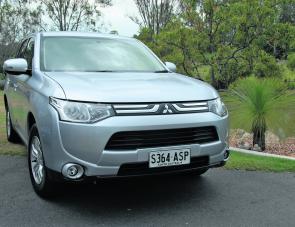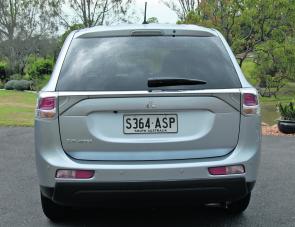Some car manufacturers are tardy about releasing new models in these hesitant financial times, but not Mitsubishi! They are obviously on the ball with restyling to suit the market and both the Challenger and Outlander have been upgraded.
For 2013 there’s a redesigned Outlander (ZG model) that is going head-to-head with the likes of the Nissan X-Trail, Honda CRV, Toyota Rav 4, Subaru Forester, Mazda CX-5 within a very tight market segment.
The Outlander is definitely appealing to its market, as it boasts 600,000 sales worldwide for Mitsubishi and Australia is rated number four in take up.
Within the 2013 Outlander petrol engine line up there’s a new entry level 2WD (ES) model with a 2L engine that offers a staggering $5,000 price advantage over previous entry models.
Next up the ladder is the 2WD or 4WD LS with 2.4L petrol linked to standard CVT gearing. A seven seat, reversing camera and upgraded audio and media systems are optional extras with the 4WD LS.
Lastly is the ‘all bells and whistles’ flag ship, Aspire. It comes complete with both leather and wood interior trim, 18” wheels, very large colour touch screen and Rockford Fosgate audio and Sat/Nav system, and of course the seven seat package.
In Outlander’s diesel guise there’s the new 2.2L direct injection turbo diesel. Figures of 110kW of power and 360Nm of torque are tantalising.
The petrol V6 engine has gone from the Outlander’s engine bay; the push towards better fuel consumption seeing its demise.
The LS specced five-seater 2WD reviewed was powered by a four-cylinder in-line 2L petrol engine mated to a CVT stepless auto unit. There were column paddles for those that like to select six forward gears manually for the fun of it.
The single overhead cam 16 valve 2L engine is derived from the Lancer and packs a fair punch, with 110kW of power and 190Nm of torque.
There’s also an entirely new, softer, body shape – gone is the ‘jet fighter engine’ Evo-inspired grille of last year’s Outlander. Those squared lines front and rear we were accustomed to are also just a memory. In essence the Generation Three Outlander is an entirely different body shape, with some changes to recognised features balanced carefully by changes to the interior cabin quality.
One change involved scrapping the drop down tailgate, which was really handy as a small seat and for ease of loading, but now totally redesigned from the vehicle. On the plus side is an upgrade to cabin quality all round with significant improvement over the dated plastics of the previous model.
The dash is comprised of metallic black panelling, with silver edging a nice touch. The six speaker audio system with CD/MP3 stereo and USB port blending in quite unobtrusively within the central dash area. A glance on the Multi Information dash screen reveals the current radio station (plus others pre-selected), and the climate control air conditioning sits within easy reach of driver and front passenger.
For the driver’s convenience there’s height and reach adjustment for the steering wheel, audio and cruise control systems on the leather bound wheel along with the Outlander’s Blue Tooth hands-free phone connectivity. The LS also comes with a reasonably large and well calibrated reversing camera screen. Headlights, always worth a mention as so many modern vehicles fall down in this regard, are up to Mitsubishi’s high standard.
The improvement to the new Outlander is also seen in an increased room for the second row of seats. Leg and head room is more generous than most competitors in this market niche. And there’s multi adjustable backrest angle for best comfort as well.
On the debit side is a slight reduction in rear cargo area, associated with the aforementioned tail gate changes. Capacity with back seats upright is now 477L and with seats folded down to make a flat floor there’s an area of 1608L. By most standards, however, this is still quite a workable load area and comes with a cargo blind.
Common to all grades of Outlander is electro mechanical steering, which is a tad vague at times although quite light. Once one becomes accustomed to it the system is fairly consistent and I found parking a breeze.
Whether in the city or on the highway the Outlander was a well balanced and tactile vehicle to drive. The 2L petrol engine driving front wheels had ample power for highway overtaking, although the CVT unit tended to buzz at higher revs. I did notice the curtailment of roll during hard corners, an improvement on the previous model in this regard, although some understeer can be noted at times when the Outlander was pushed just a tad hard into corners.
Suspension is just right; plenty of coverage over indifferent surfaces without passenger intrusion.
An interesting item in the LS was the ‘Eco’ driving system. Activated via a dash button, the system ‘trains’ the driver with a fun sort of game where a green bar moves left to right to tell the driver how much fuel is being currently used. Factory claims are 6.6L per 100km but the best I could manage was around 7L per 100km even playing the Eco game to my best ability.
Overall, the Outlander is a better car to drive than the previous model, as it should be. Improvements to interior finish and roominess will be appreciated. The loss of the split tail gate can be tolerated and there’s still a stack of rear room with seats folded either singly or both down.
The Outlander comes with a five star ANCAP rating and offers Mitsubishi’s 5 year, 130,000km warranty. Safety features include seven air bags, electronic stability control, active traction control, hill start control, ABS with electronic brake force distribution; all within an impact-resistant safety body.
All important towing capacity for the LS petrol was 1600kg. Price is around the $35,000 mark.
Reads: 2142
New styling is a distinctive feature of this year’s ZG Outlander.

The trade mark ‘jet fighter engine’ grille of the Outlander has vanished with this year’s re-styling, the overall design remains eye pleasing.

New and distinctive rear treatment has also softened the 2013 Outlander’s profile.

Rear seat passengers will find more room in the ZG Outlander in this year’s model, which makes it one of the roomiest in its class.

New dash furnishings see soft black with chrome edgings giving it a modern appearance.

With its leather trim, paddles behind the main frame and controls on the extremity the Outlander’s steering wheel is an up to date item.

The Outlander’s large reversing camera is a handy feature of this well put together vehicle.




